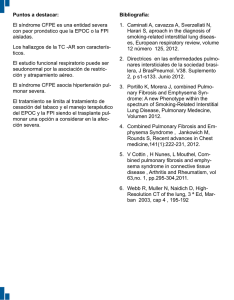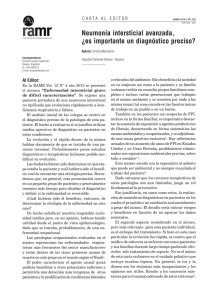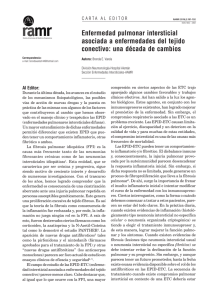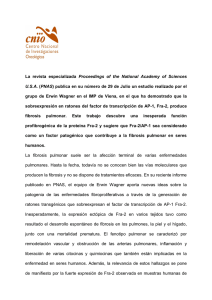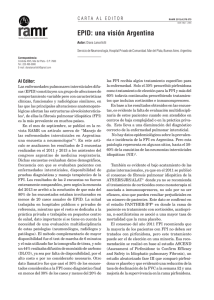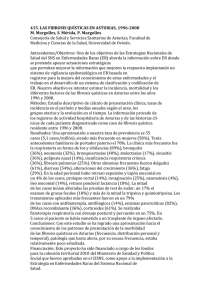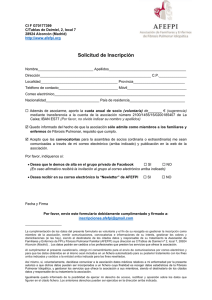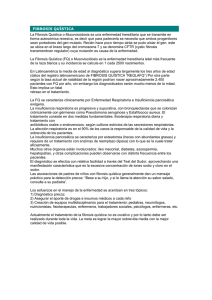rvm36409.pdf
Anuncio
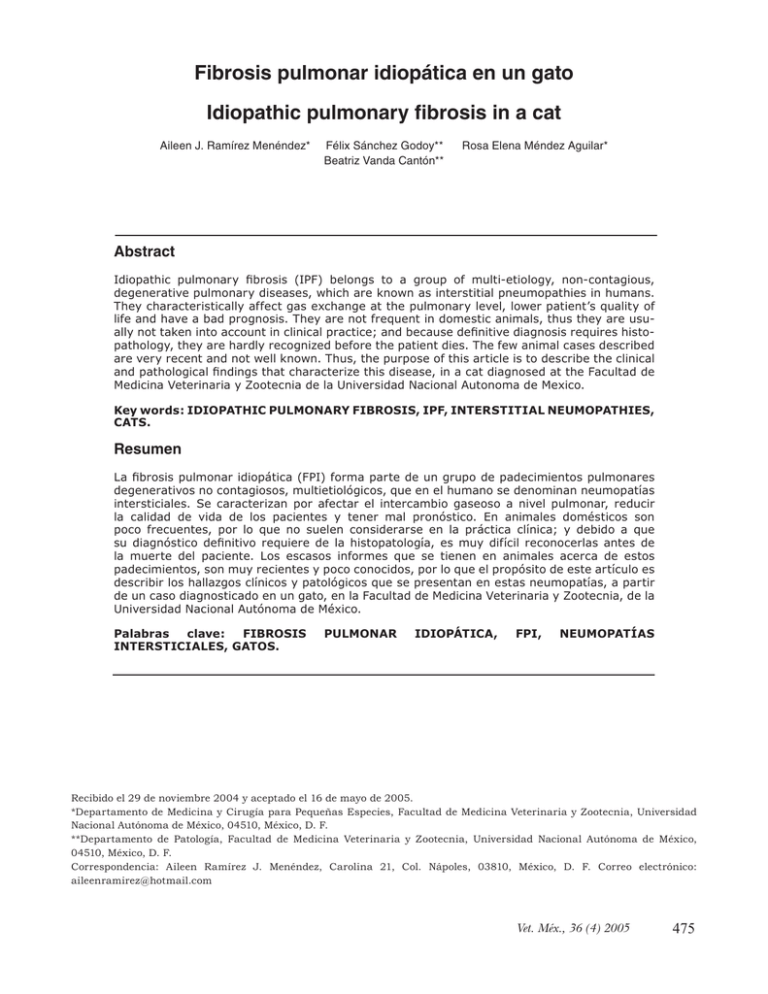
Fibrosis pulmonar idiopática en un gato Idiopathic pulmonary fibrosis in a cat Aileen J. Ramírez Menéndez* Félix Sánchez Godoy** Beatriz Vanda Cantón** Rosa Elena Méndez Aguilar* Abstract Idiopathic pulmonary fibrosis (IPF) belongs to a group of multi-etiology, non-contagious, degenerative pulmonary diseases, which are known as interstitial pneumopathies in humans. They characteristically affect gas exchange at the pulmonary level, lower patient’s quality of life and have a bad prognosis. They are not frequent in domestic animals, thus they are usually not taken into account in clinical practice; and because definitive diagnosis requires histopathology, they are hardly recognized before the patient dies. The few animal cases described are very recent and not well known. Thus, the purpose of this article is to describe the clinical and pathological findings that characterize this disease, in a cat diagnosed at the Facultad de Medicina Veterinaria y Zootecnia de la Universidad Nacional Autonoma de Mexico. Key words: IDIOPATHIC PULMONARY FIBROSIS, IPF, INTERSTITIAL NEUMOPATHIES, CATS. Resumen La fibrosis pulmonar idiopática (FPI) forma parte de un grupo de padecimientos pulmonares degenerativos no contagiosos, multietiológicos, que en el humano se denominan neumopatías intersticiales. Se caracterizan por afectar el intercambio gaseoso a nivel pulmonar, reducir la calidad de vida de los pacientes y tener mal pronóstico. En animales domésticos son poco frecuentes, por lo que no suelen considerarse en la práctica clínica; y debido a que su diagnóstico definitivo requiere de la histopatología, es muy difícil reconocerlas antes de la muerte del paciente. Los escasos informes que se tienen en animales acerca de estos padecimientos, son muy recientes y poco conocidos, por lo que el propósito de este artículo es describir los hallazgos clínicos y patológicos que se presentan en estas neumopatías, a partir de un caso diagnosticado en un gato, en la Facultad de Medicina Veterinaria y Zootecnia, de la Universidad Nacional Autónoma de México. Palabras clave: FIBROSIS INTERSTICIALES, GATOS. PULMONAR IDIOPÁTICA, FPI, NEUMOPATÍAS Recibido el 29 de noviembre 2004 y aceptado el 16 de mayo de 2005. *Departamento de Medicina y Cirugía para Pequeñas Especies, Facultad de Medicina Veterinaria y Zootecnia, Universidad Nacional Autónoma de México, 04510, México, D. F. **Departamento de Patología, Facultad de Medicina Veterinaria y Zootecnia, Universidad Nacional Autónoma de México, 04510, México, D. F. Correspondencia: Aileen Ramírez J. Menéndez, Carolina 21, Col. Nápoles, 03810, México, D. F. Correo electrónico: aileenramirez @hotmail.com Vet. Méx., 36 (4) 2005 475 Introduction Introducción D as neumopatías intersticio-alveolares difusas se caracterizan por ser enfermedades crónicas, degenerativas, no contagiosas, que provocan alteraciones inflamatorias y fibrosantes, progresivas, irreversibles y letales, en el intersticio del pulmón y paredes alveolares principalmente,1,2 pero también afectan al tejido conjuntivo peribronquiolar y perivascular, así como la luz de bronquiolos y alveólos. Algunas de estas neumopatías son: alveolitis alérgica extrínseca (neumonitis por hipersensibilidad), granuloma eosinofílico, neumonía linfoidea, bronquiolitis obliterante con neumonía organizada, enfermedades colágeno-vasculares como el lupus eritematoso, la neumonía con daño alveolar difuso y la fibrosis pulmonar idiopática (FPI), entre otras. 3 A esta última también se le conoce como alveolitis fibrosante criptogénica (AFC) 4 o neumonitis intersticial usual (NIU). 5 El término idiopático o criptogénico se refiere a que su origen es desconocido o difícil de precisar. 6,7 En humanos se han identificado entre 140 a 200 diferentes causas y factores desencadenantes de la FPI, entre las que destacan: consecuencias de neumonías virales o de neumoconiosis, exposición a ciertas drogas, gases o partículas; las etiologías más comunes se presentan en el cuadro 1. 8 Morfológicamente la FPI puede presentar un componente inflamatorio o descamativo (alveolitis), y otro de reparación (hiperplasia epitelial y fibrosis) en el intersticio alveolar; aunque ambos pueden ocurrir simultáneamente. 9,10 Al inicio predomina la fase inflamatoria, que se presenta como alveolitis o como neumonitis intersticial descamativa (NID), 5,7,9 que al volverse crónica y no resolverse adecuadamente, da lugar a una fibrosis pulmonar difusa, destruyendo las estructuras alveolocapilares y afectando la hematosis a nivel pulmonar. 4 Es muy difícil reconocer esta enfermedad en estadios iniciales, y cuando se llega al diagnóstico, suele encontrarse ya en etapas avanzadas. 6 En los perros y gatos la FPI está poco caracterizada aún, debido a la dificultad para realizar el diagnóstico clínicamente, al escaso material de biopsia y a los pocos casos que llegan a necropsia con este padecimiento.12-14 En la literatura veterinaria los informes de FPI son escasos,15 por lo que el propósito de este artículo es describir los principales signos y lesiones que se presentan en estas neumopatías, a partir del primer caso diagnosticado en la Facultad de Medicina Veterinaria y Zootecnia (FMVZ), de la Universidad Nacional Autónoma de México (UNAM), y con esto contribuir a que los médicos veterinarios conozcan mejor este tipo de padecimientos, para su oportuno y adecuado diagnóstico. iffuse interstitial and alveolar pneumopathies are characterized as chronic, degenerative, non-contagious diseases that produce inflammatory and fibrous alterations that are progressive, irreversible and lethal mainly within the pulmonary interstitial tissue and alveolar walls,1,2 although they can also affect peribronchial and perivascular tissue as well as bronchiole and alveoli lumen. Some of these pneumopathies are, among others: extrinsic allergic alveolitis (pneumonitis due to hypersensitivity), eosinophilic granuloma, lymphatic pneumonia, obliterating bronchiolitis with organized pneumonia, collagen-vascular diseases such as erythematous lupus, diffuse alveoli damage pneumonia and idiopathic pulmonary fibrosis (IPF). 3 The latter is also known as cryptogenic fibrous alveolitis (CFA) 4 or usual interstitial pneumonitis (UIP). 5 The term idiopathic or cryptogenic refers to the fact that its origin is unknown or difficult to establish. 6,7 Between 140 and 200 different causes and trigger factors of IFP have been identified in humans, which include consequences of viral pneumonias or pneumoconiosis, exposure to certain drugs, gases or particles. The most frequent etiologies are found in Table 1. 8 Morphologically, IFP can present an inflammatory or desquamating component (alveolitis) and a repairing component (epithelial hyperplasia and fibrosis) in the alveolar interstices, although both can occur simultaneously. 9,10 The inflammatory phase predominates at the onset, which is presented as alveolitis or desquamating interstitial pneumonitis (DIP), 5,7,9 when it becomes a chronic form and there is no adequate resolution a diffuse pulmonary fibrosis occurs, destroying the alveoli-capillary structures and affecting hematosis at the pulmonary level.4,11 It is hard to recognize this disease at the initial stages, and when diagnosed it is usually in the late stages. 6 The IPF is not yet well characterized in dogs and cats due to the difficulty of carrying out a clinical diagnosis, to the scarce biopsy material and to the few cases that reach necropsy with this ailment.12,13,14 In Veterinary literature the reports of IPF are few,15 therefore the purpose of this paper is to describe the main signs and lesions that are present in these pneumopathies from the first case diagnosed at the Facultad de Medicina Veterinaria y Zootecnia (FMVZ) de la Universidad Nacional Autonoma de Mexico (UNAM) and thus familiarize veterinarians with this type of ailments for their opportune and adequate diagnosis. 476 L Case description Descripción del caso A European-breed, castrated male, domestic short hair cat, 16 years old was presented with a history of 4 kg weight loss in the past six months before being presented to the Small Animal Hospital of the UNAM. The individual lived indoors and its vaccination program was up to date. In the physical exam cachexia, hirsute hair, positive cough reflex and diminished respiratory murmurs in both hemithorax were found In the pulmonary field radiographs (lateral, left-lateral, right and ventro-dorsal) a generalized structured interstitial pattern was present, compatible with pulmonary metastasis, cardiogenic edema or mycosis (Figure 1 and 2). In the electrocardiogram, low voltage QRS complexes were observed associated with the respiratory problem. In the echocardiogram, aortic and tricuspid failure were observed as well as Se trata de un gato de raza Europeo, doméstico, de pelo corto, macho, castrado, de 16 años de edad, con historia de pérdida de 4 kg de peso en los últimos seis meses antes de ser remitido al Hospital para Pequeñas Especies de la UNAM. Siempre vivió en departamento, su calendario de vacunación estaba al corriente y no salía a la calle. Al examen físico se encontró caquéctico, con el pelo hirsuto, reflejo tusígeno positivo y ruidos respiratorios disminuidos en ambos hemitórax. En las radiografías de campos pulmonares (lateral, izquierda-lateral, derecha y ventro dorsal) se apreció un patrón intersticial estructurado generalizado, compatible con metástasis pulmonar, edema cardiogénico o micosis (Figuras 1 y 2). En el electrocardiograma se observaron complejos QRS de bajo voltaje, asociados con el problema respiratorio. Figura 1. Radiografía de tórax para campos pulmonares, lateral izquierda-derecha con patrón instersticial no estructurado. Figure 1. Radiograph of thorax for left lateral and right lateral fields with unstructured interstitial pattern. Figura 2. Radiografía ventro-dorsal de tórax con patrón instersticial no estructurado. Figure 2. Ventro-dorsal thorax radiograph with unstructured interstitial pattern. Vet. Méx., 36 (4) 2005 477 hypertrophy of the left ventricle and pericardium hemorrhage. The patient also presented hypoalbuminemia and hyperglobulinemia associated with the chronic inflammation. No alterations were found in the radiographic and ultrasound examinations of the abdomen, as well as in the general urine and blood analysis. The test for feline viral leukemia was negative. The owners did not authorize hospitalization or allow a bronchial flush in order to carry out cytology and culture. Patient was sent home with 4 mg/kg of furosemide and 0.5 mg/kg enalapril. Two months later the patient showed greater weight loss. The radiographs of thorax did not show an improvement with treatment. Once again, the owners refused hospitalization. Diltiazem at 7 mg/kg as induction and then 2.5 mg/kg as normal dose was prescribed to the patient. The following week the patient presented anorexia, depression and 8% dehydration. Owners opted for euthanasia. The body was sent to the Pathology Department of the FMVZ in the UNAM, where necropsy was carried out. The most relevant lesions were found in the cardiopulmonary block as follows: abundant light yellow mucous secretion that obstructed the lumen of the trachea, main and secondary bronchia; diffuse thickening of the pleura, pulmonary lobules did not collapse, they were heavy and firm, and with multiple circular white-yellowish areas of 0.3-1 cm in diameter, both in the pleura as well as in the parenchyma (Figure 3). When cut, the surface had a beehive appearance, some bronchia appeared dilated (bronchiectasia) and with abundant mucous, similar to the one described above (Figure 4). The cranial lobules presented numerous bullae, suggesting the presence of emphysema. Approximately 15 mL of fluid were found in the pericardium sac. Hypertrophy and dilation of the right ventricle were observed (cor pulmonale), also the left ventricle was thickened with a decrease in the cardiac chamber with a En el ecocardiograma se observó insuficiencia aórtica y tricuspídea, hipertrofia del ventrículo izquierdo y derrame pericárdico. Mostraba hipoalbuminemia e hiperglobulinemia asociada con la inflamación crónica. En los exámenes radiográficos y ultrasonográfico de abdomen, en el examen general de orina y en el hemograma, no se apreciaron alteraciones. La prueba de leucemia viral felina fue negativa. Los propietarios no autorizaron su hospitalización ni permitieron que se realizara lavado bronquial para hacer citología y cultivo. Se envió a su casa con furosemida 4 mg/kg y enalapril 0.5 mg/kg. Dos meses después mostraba mayor pérdida de peso. Las radiografías de tórax no mostraron mejoría alguna con el tratamiento. Los propietarios siguieron renuentes a hospitalizarlo. Sólo se le prescribió diltiazem a 7 mg/kg como inducción y después a 2.5 mg/kg. A la semana siguiente presentó hiporexia, depresión y deshidratación del 8%. Los propietarios optaron por la eutanasia. El cadáver fue remitido al Departamento de Patología de la FMVZ-UNAM, donde se le realizó la necropsia. Las lesiones más relevantes se encontraron en el bloque cardiopulmonar y fueron: abundante moco de color amarillo claro que obstruía la luz de la tráquea, bronquios principales y secundarios; engrosamiento difuso de pleura, los lóbulos pulmonares no colapsaron, eran pesados, firmes al tacto y con múltiples áreas circulares de color blanco amarillento de 0.3-1 cm de diámetro, tanto en la pleura como en el parénquima (Figura 3). Su superficie de corte tenía apariencia de panal, y algunos bronquios se apreciaron dilatados (bronquiectasia) y con abundante cantidad de moco como el descrito previamente (Figura 4). Los lóbulos craneales presentaron numerosas bullas que sugerían enfisema. Había hidropericardio de aproximadamente 15 mL. Se observó dilatación e hipertrofia del ventrículo derecho (cor pulmonale), el ventrículo izquierdo estaba Figura 3. Vista dorsal de los pulmones, que exhiben aumento de tamaño y áreas blanco-amarillentas, firmes al tacto, que corresponden a fibrosis. Figure 3. Dorsal view of the lungs showing increase in size and white yellowish areas that are firm and correspond to fibrosis. 478 Figura 4. Corte transversal de un lóbulo pulmonar en el que se observa engrosamiento de la pleura visceral, y áreas blancas subpleurales que corresponden a fibrosis. La flecha blanca señala un bronquio dilatado y obstruído por un tapón de moco. Figure 4. Transverse cut of a pulmonary lobule where thickening of the visceral pleura can be observed, as well as sub-pleural white areas that correspond to fibrosis. The white arrow points to a dilated bronchiole that is obstructed by a mucous plug. Figura 5. Fotomicrografia de pulmón. Se observan fibrosis pleural e intersticial, así como sobredistensión y enfisema alveolar (hematoxilina y eosina, 4X). Figure 5. Lung micrography. Pleural and interstitial fibrosis can be observed, as well as over-distension and alveolar emphysema (Hematoxylin and eosin, 4X). relationship VI/VD of 6:1 (normal relationship is 3:1), which is interpreted as left concentric hypertrophy. In the histology slides of the lung, extensive areas of interstitial fibrosis, both mural and pleural were observed, as well as alveolar emphysema (Figure 5), histiocytic and lymphoplasmocytic interstitial inflammation, hyperplasia of the interstitial smooth muscle, hyaline membranes, squamous metaplasia in alveoli and bronchioles, hyperplasia of type II pneumocytes, and numerous macrophages and neutrophils in the alveolar lumen (Figure 6). Stains were carried out with Periodic Acid-Schiff stain (PAS) that confirmed the presence of mucous secretion and with Masson’s trichromatic stain that highlighted the presence of the fibroplasia and hyperplasia of the interstitial smooth muscle (Figure 7). According to the histopathology findings, this case was consistent with the desquamating form of IPF, which is characterized by accumulation of intraalveolar macrophages, as well as by the presence of “patchy” fibrosis in the interstices, excessive distension of the aerial spaces and formation of bulla or bubbles that give the lung a “beehive” appearance. 3,6,8,9 This disease has a torpid evolution and a bad prognosis; the patients have hypoxemia, cor pulmonale and severe respiratory failure, they also show cyanosis, dyspnea, engrosado con disminución de la cámara cardiaca, cuya relación era de VI/VD 6:1 (la relación normal es de 3:1), lo que se interpreta como hipertrofia concéntrica izquierda. En los cortes histológicos del pulmón se observaron extensas áreas de fibrosis intersticial mural y pleural, así como enfisema alveolar (Figura 5), inflamación intersticial histiocítica y linfoplasmocítica; hiperplasia del músculo liso intersticial, membranas hialinas, metaplasia escamosa en alvéolos y bronquiolos, hiperplasia de neumocitos tipo II y numerosos macrófagos y neutrófilos en la luz alveolar (Figura 6). Se realizaron tinciones con ácido peryódico de Schiff (PAS) que confirmaron la presencia de moco, y tricrómica de Masson que puso de manifiesto la fibroplasia y la hiperplasia de músculo liso intersticial (Figura 7). De acuerdo con los hallazgos histopatológicos, este caso fue consistente con la forma descamativa de la FPI, la cual se caracteriza por acumulación de macrófagos intralveolares, así como por la presencia de fibrosis “en parches” en el intersticio, sobredistensión de los espacios aéreos, y formación de bullas o burbujas que le dan al pulmón un aspecto de “panal de abeja”. 3,6,8,9 Esta enfermedad tiene una evolución tórpida y con mal pronóstico; los pacientes cursan con hipoxemia, cor pulmonale e insuficiencia respiratoria Vet. Méx., 36 (4) 2005 479 Figura 6. Fotomicrografia de pulmón, en la que se aprecia hiperplasia de neumocitos tipo II, con macrófagos y neutrófilos en la luz alveolar (hematoxilina y eosina, 40X). Figure 6. Lung micrography, where hyperplasia of pneumocytes type II are observed with macrophages and neutrophils in the alveolar lumen (Hematoxylin and eosin, 40X). Figura 7. Detalle de una zona de fibrosis en pulmón, caracterizada por proliferación de fibroblastos que se encuentran rodeados por colágena (tricrómica de Masson, 40X) Figure 7. Detail of a lung area with fibrosis, characterized by proliferation of fibroblasts that are surrounded by collagen (Masson’s trichromic, 40X). unproductive cough and fatigue which forces them to restrict their activities,16 reducing their quality of life. It is thought that the onset of IPF can be a consequence of an inflammatory process –either infectious, immune-mediated or of toxic origin– that is not fully resolved and is perpetuated, giving rise to a repair process with fibroblast proliferation and an exacerbation in the synthesis of collagen.17 It could also decrease the remodeling of collagen, probably due to a deficiency in the expression or function of the metalloproteinases (enzymes dependant on zinc capable of digesting components of basal membranes). 3,7 Given that the remodeling of the pulmonary interstitial matrix depends on an adequate balance between collagen synthesis and degradation, it is possible that during pathogenesis of the fibrosis there is a disequilibrium between the metalloproteinases in charge of degrading the interstitial collagen and their tissue inhibitors (TIMPs).18 It has been mentioned that immune complexes can also have an important part in this disease as they are chemiotactic for neutrophils and activate macrophages, and could produce cytokines such as interleukin 1, which stimulates the proliferation of fibroblasts, as well as other factors that abnormally increase collagen synthesis. 9,19,20 480 grave, muestran cianosis, disnea, tos no productiva y fatiga, que los obliga a restringir sus actividades,16 reduciendo su calidad de vida. Se cree que la FPI puede iniciar como consecuencia de un proceso inflamatorio —ya sea de origen infeccioso, inmuno mediado o tóxico—, el cual no se resuelve por completo, sino que se perpetua, dando lugar a un proceso de reparación con proliferación de fibroblastos y exacerbación en la síntesis de colágena; 17 o bien, por una disminución en la remodelación de ésta, probablemente por deficiencia en la expresión o en la función de las metaloproteinasas (enzimas dependientes de zinc, capaces de digerir componentes de las membranas basales). 3,7 Dado que la remodelación de la matriz del intersticio pulmonar depende de un balance adecuado entre la síntesis y la degradación de colágena, es posible que durante la patogénesis de la fibrosis, ocurra un desequilibrio entre las metaloproteinasas encargadas de degradar la colágena intersticial y los inhibidores tisulares de dichas metaloproteinasas (TIMP).18 Se menciona que los complejos inmunes también pueden participar de manera importante en esta patogenia, los cuales son quimiotácticos para neutrófilos y activan macrófagos, pudiendo producirse citocinas como la interleucina-1, que estimulan la proliferación de fibroblastos; así An exhaustive clinical history and physical exam are required. In the radiographic study the lungs can be seen as “unpolished glass” during the inflammatory phase of the IPF, which indicates a better prognosis; nevertheless, reticulo-nodular images (alveolar pattern) with bilateral cysts or a “beehive” lung suggest fibrosis in advanced stages.15,21 Arterial gas analysis shows hypoxemia, and if there is also hypercapnia, it means that there is an advanced destruction of the pulmonary parenchyma. Laboratory analysis usually do not indicate particular alterations, although in the majority of these cases there can be an increase of gamma globulins, mainly IgG. In a bronchiole and alveolar flush an increase in neutrophils (40-50%) and eosinophils (40%) can be seen with an absence of infection. 22 Nevertheless, the “golden” diagnostic test for interstitial pneumopathies is a pulmonary biopsy, 4 where the percentage of inflammation versus fibrosis can be assessed, and prognosis will be better evaluated. 23 If the inflammation is larger than fibrosis, the animal will respond better to treatment and so will be its prognosis. In humans, respiratory function tests are also carried out. These demonstrate a restrictive pattern in the pulmonary capacity and a decrease in distension capability. 24 Due to the fact that the etiology and pathogenesis of IPF are well established, the therapeutic measures, as in all of the chronic degenerative diseases, are limited and sometimes only palliative. Therefore, the treatment must be oriented, in the first place, to provide a better quality of life for the patient and, if possible, to increase their life expectancy. Contact with the fibrosis causing agents, listed in Table 1, must be avoided. Therapy includes anti-inflammatory drugs, mainly corticosteroids (prednisone) and other cytotoxic immunodepressants such as cyclophosphamide, azatioprin or cyclosporine 7,15,19 combined with anti-fibrosis agents (d-penicilamine, colchicine) 25 complemented with antioxidants (glutathione, n-acethylcystein) and bronchodilators or ß-adrenergic substances. Other measures that help the patient are: respiratory rehabilitation, oxygen therapy and, as a surgical option, a lung transplant. Many of these measures are hard to implement in Veterinary Medicine, but a good option are steroids at anti-inflammatory dosages. Although the duration of treatment has not been well established, it is based on the response to treatment. It must be noticed that steroids, when administered for long periods of time, cause Cushing’s syndrome and immunosupression. When the fibrous component predominates over the inflammatory one, no favorable response to treatment is observed and the prognosis is bad. como otros factores que incrementan la síntesis de colágena en forma aberrante. 9,19,20 Se requiere de una exhaustiva historia clínica y examen físico. En el estudio radiográfico se pueden apreciar los pulmones en “vidrio despulido” durante la fase inflamatoria de la FIP, lo que indica un mejor pronóstico; en cambio, imágenes reticulonodulares (patrón alveolar) con quistes bilaterales, o pulmón “en panal”, sugiere fibrosis en etapas avanzadas.15,21 La gasometría arterial muestra hipoxemia y si además hay hipercapnia, significa que hay una destrucción avanzada del parénquima pulmonar. Los exámenes de laboratorio no suelen tener alteraciones particulares, aunque en la mayoría de estos casos puede haber aumento de gammaglobulinas, principalmente de IgG. En el lavado bronquioloalveolar se observa incremento de neutrófilos (40%-50%) y eosinófilos (40%) en ausencia de infección. 22 Sin embargo, la prueba diagnóstica “de oro” para las neumopatías intersticiales es la biopsia pulmonar; 4 en ella se evalúa el porcentaje de inflamación contra el de fibrosis, lo que resulta de gran valor pronóstico, 23 ya que si la inflamación es más extensa que la fibrosis, el animal responderá mejor al tratamiento y tendrá mejores expectativas. En humanos se realizan además pruebas de función respiratoria, las cuales muestran un patrón restrictivo en la capacidad pulmonar, y una disminución de la distensibilidad. 24 Debido a que la etiopatogenia de la FPI no está esclarecida del todo, las medidas terapéuticas, como en todas las enfermedades crónico-degenerativas, son limitadas y en ocasiones sólo son paliativas; por lo que el tratamiento debe estar orientado en primer lugar, a proporcionar una mejor calidad de vida al paciente, y si es posible, aumentar también su sobrevida. Hay que evitar que se exponga a los agentes fibrosantes que se muestran en el Cuadro 1. La farmacoterapia incluye antiinflamatorios, principalmente corticoesteroides (prednisona) y otros inmunodepresores citotóxicos como ciclofosfamida, azatioprina o ciclosporina; 7,15,19 combinados con antifibrosantes (d-penicilamina, colchicina) 25 complementados con antioxidantes (glutatión, n-acetilcisteína) y broncodilatadores o adrenérgicos-ß. Otras medidas que ayudan a los pacientes, son la rehabilitación respiratoria, oxigenoterapia y, como opción quirúrgica, el transplante de pulmón. Muchas de estas medidas son difíciles de implementar en medicina veterinaria, pero una buena opción son los esteroides a dosis antiinflamatorias, sólo que la duración del tratamiento no está bien establecida, sino que se basa en la respuesta al tratamiento y no hay que olvidar que los esteroides, cuando se administran por periodos prolongados, provocan síndrome de Cushing e inmunodepresión. Cuando predomina el componente fibrótico sobre el Vet. Méx., 36 (4) 2005 481 Cuadro 1 CAUSAS MÁS COMUNES DE NEUMOPATÍAS INTERSTICIO-ALVEOLARES DIFUSAS MOST COMMON CAUSES OF DIFFUSE INTERSTITIAL-ALVEOLAR PNEUMOPATHIES Inorganic particles Organic particles (pneumoconiosis) Drugs Gases, smoke, Collagen-vascular diseases vapors and aerosols Silica, silicates, aluminum, heavy metals, iron, quartz, marble dust Bird droppings, Aspergillus .spp Cyclophosphamide, Chlorine gas, sulfoxides, resins, toluene, mercury, paraquat sulfonamide, bleomycin, propranolol, Rheumatic arthritis, systemic erythematous lupus diphenylhydantoin, methotrexate Conclusion The IPF has to be considered as a differential diagnosis in cases of interstitial pneumonias and chronic bronchitis in dogs and cats. 26 Reaching the definitive diagnosis is difficult, and a pulmonary biopsy is needed, 2,4 because clinically and in radiographs it can be confused with mycosis, neoplasia, cardiogenic pulmonary edema, granulomatous pneumonia or pleural hemorrhage. 27 The prognosis depends on the relation between the degree of inflammation and the fibrosis; when inflammation percentage is higher there is a greater life expectancy, and when fibrosis is higher prognosis is reserved. In future studied cases, it will be possible to learn more about this physiopathology, make opportune diagnosis, and give adequate treatments to improve patients’ quality of life.1,2 Referencias 1. Crystal R, Gadek J, Ferrans V, Fulmer J, Line B, Hunninghake G. Interstitial lung disease. Current concepts of pathogenesis, staging and therapy. Am J Med 1981; 70:542-568. 2. Katzenstein AA, Fiorelli RF. Nonspecific interstitial pneumonia/fibrosis. Histologic features and clinical significance. Am J Surg Pathol 1994; 18:136-147. 3. Colby TV. Pathologic spectrum and differential diagnosis of idiopathic interstitial pneumonias: In: American Thoracic Society. Idiopathic interstitial pneumonia: Current concepts and management. Postgraduate course. 1996 May 7-10, New Orleans: American Thoracic Society, 1996 4. Egan JJ, Woodcock AA. Does the treatment of cryptogenic fibrosing alveolitis influence prognosis? Respir Med 1996; 90:127-130. 5. Wallace WA, Lamb D. Cryptogenic fibrosing alveolitis: a clinico-pathological entity. Curr Diagn Pathol 1996; 3: 27-34. 482 inflamatorio, no se observa respuesta favorable al tratamiento y el pronóstico es malo. Conclusión La FPI deberá considerarse como un diagnóstico diferencial en los casos de neumonías intersticiales y bronquitis crónicas en perros y gatos. 26 Llegar al diagnóstico definitivo es difícil, y para ello es necesario realizar biopsia pulmonar; 2,4 ya que clínica y radiográficamente se puede confundir con micosis, neoplasias, edema pulmonar cardiogénico, neumonía granulomatosa o derrame pleural. 27 El pronóstico depende de la relación entre el grado de inflamación y la fibrosis, a mayor porcentaje de inflamación, mayor sobrevida, y a mayor porcentaje de fibrosis, el pronóstico empeora. Si se estudian más casos, es posible que en lo futuro se conozca más acerca de su fisiopatología, y se puedan diagnosticar mejor, para aplicar un tratamiento oportuno y adecuado, que pueda ofrecer mejores condiciones de sobrevida a los pacientes.1,2 6. Cotran RS, Kumar V, Robbins SL. Patología estructural y funcional. 5 a ed. Madrid: Interamericana- McGrawHill, 1995. 7. Miller LG, Kazemi H. Manual clínico de neumología. México: McGraw-Hill; 1984: 239-275. 8. Crystal RG, Bitterman PB, Rennard SI, Hance A, Keog B. Interstitial lung diseases of unknown cause. N Engl J Med 1984; 310:154-166. 9. Tubbs R, Benjamin S, Reich N, McCormack L, Van Ordstrand S. Desquamative interstitial pneumonitis, cellular phase of fibrosing alveolitis. Chest 1977; 72: 159-166. 10. Winterbauer R, Hammar S, Hallman K, Hays J, Pardee N, Morgan E et al. Diffuse interstitial pneumonitis. Clinicopathologic correlations in 20 patients treated with prednisone/azathioprine. Am J Med 1978; 3:579-592. 11. Lobetti RG, Milner R, Lane E. Chronic idiopathic pulmonary fibrosis in five dogs. J Am Anim Hosp Assoc 2001; 37:119-27. 12. Rhind SM, Gunn-Moore DA. Desquamative form of cryptogenic fibrosing alveolitis in a cat. J Comp Pathol 2000; 123: 226-229. 13. Moses BL, Spaulding GL. Chronic bronchial disease of the cat. Vet Clin North Am Small Anim Pract 1985; 15: 929-947. 14. Bonagura JD, Hamlin RL, a Gaber CE. Chronic respiratory disease in the dog. In: Kirk RW, Bonagura JD, editors. Current Veterinary Therapy X. Philadelphia: Saunders Co, 1989: 361-368. 15. Corcoran BM, Cobb M, Martin MWS, Dukes-McEwans J, French A, Fuentes VL et al. Chronic pulmonary disease in West Highland White Terriers. Vet Rec 1999; 144:611-616. 16. Javaheri S, Sicilian L. Lung function, breathing pattern, and gas exchange in interstitial lung disease. Thorax 1992; 47:93-97. 17. Mariani TJ, Roby Jd, Mecham RP, Parks WC, Crouch E, Pierce RA. Localization of type I procollagen gene expression in silica-induced granulomatous lung disease and implication of transforming growth factor- as a mediator of fibrosis. Am J Pathol 1996; 148:151-164. 18. Perez-Ramos J, Segura ML, Vanda B, Selman M, Pardo A. Matrix metalloproteinases 2, 9, and 13, and tissue inhibitors of metalloproteinases 1 and 2 in experimental lung silicosis. Am J Respir Crit Care Med 1999; 160:1274-1282. 19. Silver RM, Warrick JH, Kinsella MB, Staudt LS, Baumann MH, Strange C. Cyclophosphamide and low dose prednisone therapy in patients with systemic sclerosis (scleroderma) with intrstitial lung disease. J Rheumatol 1993; 20:838-844. 20. Selman M, Chapela R, Montaño M, Soto H. Cambios en el contenido de colágena en diferentes enfermedades fibrosantes del pulmón. Arch Invest Med 1982; 13:93-100. 21. Leung AN, Miller RR, Müller NL. Parenchymal opacification in chronic infiltratiave lung diseases: CT-pathologic correlation. Radiology 1993; 188:209-214. 22. Nagai S, Aung H, Tanaka S, Satake N, Mio T, Kawatani A et al. Bronchoalveolar lavage findings in patients with BOOP and related disease. Chest 1992;102:325-375. 23. Raghu G. Idiopathic pulmonary fibrosis, a rational clinical approach. Chest 1987; 92:148-154. 24. Martínez D, Pérez J, Rojas A, Chapela R, Selman M. Vía aérea periférica y zona de transición en fibrosis pulmonar idiopática y alveolitis alérgica extrínseca. Neumol Cir Tórax 1984; 45:31-35. 25. Peters SG, McDougall Jc, Douglas WW, Coles DT, DeRemee RA. Colchicine in the treatment of pulmonary fibrosis. Chest 1993; 103:101-104. 26. Corcoran BM, Foster DJ, Fuentes VL. Feline asthma syndrome. J Small Anim Pract 1995; 36:481-488. 27. Suter PF, Lord PF. Thoracic radiograph. A text atlas of thoracic diseases of the dog and cat. Switzerland: Suter PF, 1984 Vet. Méx., 36 (4) 2005 483
